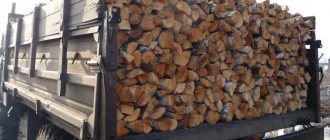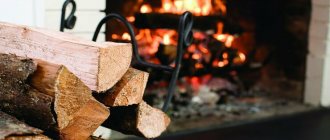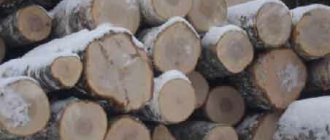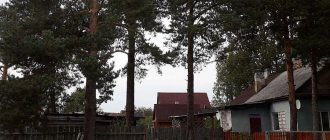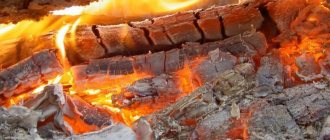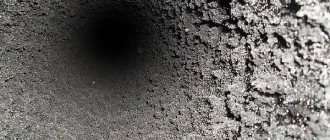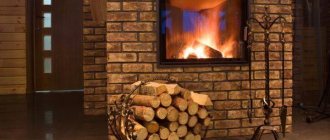It is a priori pleasant to see a live fire in your stove; it creates a cozy and comfortable atmosphere throughout the whole house, but do not forget that its main task is to heat the room. Efficient operation of the stove will allow you to warm up the space of the house at any time of the year and heat the bathhouse.
It is desirable that lighting the stove does not take much time, and the heat from it, on the contrary, lingers for a long time. This can be done by choosing the right fuel, in particular firewood. In this article we will talk about what kind of firewood is best to heat the stove, we will focus on different types of wood, we will study deciduous and coniferous options and specific types of wood.
Nice glowing fire in the stove
Choosing firewood according to the characteristics of the breed
Firewood belongs to the category of goods that are not transported from afar, but are content with those that are harvested in nearby areas. Otherwise, transportation costs more than the fuel itself. But if you have a choice, you should think about which firewood is better, analyze the prices and buy high-quality fuel.
Chopped firewood is more expensive Source bizorg.su
Whenever possible, preference is given to hard hardwoods with a dense wood structure that burn hot and long. Coniferous firewood is also used, but, given its resinous nature and the formation of soot, they try to do this not all the time.
We invite you to learn more about the different types of firewood and their efficiency for heating.
Oak
In all respects, oak firewood is considered the best for stove heating, but also the most expensive. Hard and dense oak wood:
- burns for a very long time;
- gives off more heat than all other breeds;
- due to slow and long burning it is economically consumed;
- emits a pleasant forest aroma and releases beneficial fumes.
These qualities are most characteristic of firewood from middle-aged trees. Below you can see which firewood is the hottest: the calorific value table for the main types puts oak in first place.
Heat transfer depends on the moisture content of the wood Source baza-drov.com.ua
Beech, ash, maple
Wood with properties similar to oak are ash, maple, yew, beech, hornbeam and other hardwoods. They are also difficult to ignite, but burn for a long time and release a large amount of heat.
But firewood from maple, beech and hornbeam is almost never found on sale, since these species are valuable and are not cheap; using them for heating a house is too wasteful. Firewood made from yew, acacia and ash is more affordable in price and availability, but it is better to use it sparingly - in severe frosts or for gatherings by the fireplace.
Typically, only waste of valuable species from woodworking or furniture production is used for firewood Source ytimg.com
What are there
In order to choose the right firewood for kindling, you need to know the properties of wood species. The following characteristics of firewood exist:
- heat transfer coefficient;
- degree of flammability;
- amount of ash;
- smoke production during combustion.
Ideal firewood should have excellent flammability and heat transfer, produce little smoke and leave a minimum of ash after combustion. And these qualities depend not only on the type of wood, but also on the degree of dryness, that is, on the percentage of remaining moisture.
A freshly cut log burns poorly due to high humidity. That's why it's best to harvest firewood in the middle of winter. Previously, in villages it was customary to do this no earlier than “winter Nikola”, December 19th. At this time, the sap from the trees partially goes into the ground. The trees seem to be in suspended animation.
Video description
How to clean a chimney by burning aspen or sedge firewood, watch the video:
Linden
Like birch, linden firewood is stored no longer than two to three years, after which it loses quality. However, they are highly valued as fuel for sauna stoves, as they are capable of burning very intensely and heating it in a short time.
When burned, linden produces aromatic smoke and releases phytoncides with medicinal properties that promote wound healing and alleviate the symptoms of pulmonary diseases.
Linden is an excellent fuel for a bath Source element-house.ru
Linden firewood is not suitable for constant heating of a house in winter due to its ability to burn out too quickly.
Alder
Alder wood is the most beautiful and if you choose from an aesthetic point of view, logs of rich orange, ocher or almost red color will become an excellent decor near the stove. In terms of the amount of heat generated, alder belongs to the second, middle group, although its density is at the level of the third (up to 540 kg/m³). Like birch, the high calorific value of alder is due to the low humidity of the tree even in its raw state, not to mention dry firewood. When burning, alder logs almost do not smoke and do not emit soot at all, as they are characterized by minimal resin content. Alder firewood, wood chips or sawdust are added during smoking to give the smoke a pleasant aroma if wood from fruit varieties is not available. Fireplaces are lit together with birch and alder logs, as they do not crackle, but produce both a beautiful flame and intense heat.
How to prepare and store firewood
You can buy oak, birch or poplar for firewood in the form of whole logs or already split into logs. There is another option - to purchase waste in the form of branches, twigs, bark, but it may only be of interest to summer residents who come to relax by the fire.
It is more profitable to purchase unchopped firewood, but if there is no one to chop it, preference should be given to the seller who carefully and tightly placed the logs in the back of the car or woodpile. The fact is that the unit of measurement for firewood when selling is a cubic meter. If they are folded carelessly, there will be a lot of empty spaces between them, and you will literally pay some of the money for air.
It is impossible to determine the true volume of piled firewood. Source drovenik.ru
Split firewood is stored for storage, since logs take longer to dry, and birch logs can generally rot. The woodpile is placed under a canopy or in a special woodshed with ventilated walls. It is also possible in the open air, but by making a flooring above the ground and covering or laying the top row so that precipitation does not seep inside.
Linden
Like alder, linden firewood has a low density; it is also in the third group and produces less heat - at the level of spruce or poplar wood. Linden, rather from the section on what kind of deciduous firewood is better not to use for heating a house, since the output from them is small and they burn quickly. Consequently, much more of this wood will have to be prepared, and the ash pit will have to be lined and cleaned much more often. Such fuel is unprofitable both financially and unattractive in terms of labor intensity - first the logs will have to be chopped, then the logs will have to be stacked, and then constantly brought in. But when choosing firewood for a bathhouse or for a fireplace, this breed attracts with its aroma, and is even positioned as medicinal. Knowing which firewood is more effective for heating the stove, and which can and should be used for other purposes, you can actually prepare the optimal supply.
Video description
See the video for what improper storage leads to:
For fireplaces and pyrolysis stoves, it is advisable to further dry the fuel by keeping it in a warm and dry place for several days. The “cleaning” firewood – aspen and alder, used for cleaning chimneys – should also be well dried.
It is advisable to harvest oak in advance and put it into use after a year or two - this is the time it takes for the wood to dry. Birch, on the contrary, is used in the year of purchase. Linden is stored for no longer than 2-3 years if you want to enjoy its amazing aroma in the bathhouse.
Aspen
Aspen firewood is at the bottom of the rating both in terms of density and calorific value, but it burns without smoke, without soot, and without soot. On the contrary, they are used to clean the chimney, since the vapors released by wood during the combustion process can settle on the sooty walls and corrode soot deposits. If you use aspen for periodic burning, it will be much easier to maintain the chimney in working condition. It will not be possible to completely get rid of the need for periodic maintenance, but it is possible to reduce the number of approaches and labor costs. You can also light a stove with aspen splinters; they set quickly. When choosing what kind of firewood will be needed in large volumes, aspen is definitely not in the top. It is enough to prepare a dozen or two logs of it, but if the stove is not only in the house, but also in the bathhouse, and there is also a fireplace, the reserves should be increased.
Softwood firewood: pine, spruce, larch
By the characteristic crackling of the logs, which literally caresses the ear, and the bright scattering sparks, you can determine the combustion of pine logs. They give off a lot of heat, but burn out quite quickly. But many shortcomings are quickly forgotten thanks to the unique resinous aroma that comes from burning pine or spruce firewood. Only in this case you should be extremely vigilant, since sparks shooting out from time to time can cause a lot of trouble. Therefore, it is necessary to observe safety precautions.
It is worth noting that pine logs produce more heat than spruce logs. Largely due to the high content of resinous substances, due to which the above-mentioned aroma is released. Pine and spruce, it produces an equally invigorating effect. In addition, it can have a tonic effect on the organs of the upper respiratory tract. In addition, spruce logs have a “shooting” effect, while pine firewood has a smoke effect. But the wood of both species splits and melts easily, although it smokes heavily.
As for larch, rarely does anyone light a firebox with such wood due to its low prevalence. It should be taken into account that when logs burn, carbon monoxide is released in large quantities. For this reason, you should not immediately close the damper, and your country house or country cottage should have high-quality ventilation.
A couple of phrases about calorific value
In terms of its chemical composition, wood is a rather complex material. It contains the main components - lignin and cellulose. But besides them, the tree contains:
- resins;
- proteins;
- tannins and other ingredients.
When logs burn in a stove (or simply when trees burn in a forest), these components interact with the air at a chemical level. The calorific value of wood (as well as any fuel), or thermal conductivity, is the amount of thermal energy that a unit of weight of the fuel material (in our case, 1 kg of wood) produces during combustion. Kilocalories are used to measure quantities.
The chemical composition among most tree varieties has minimal variations, which causes differences in the number of calories emitted. That is, the heat of combustion of some types of firewood can be as follows:
- for deciduous species the figure is 4460 kcal/kg;
- for coniferous species - 4560 kcal/kg;
- for mixed breeds – 4510 kcal/kg.
As you can see, the differences are minimal. At the same time, it is easy to understand that it is better to use coniferous wood for the stove due to its greater thermal conductivity. Only firewood is supplied to the market depending on volume, not weight. That is, the main criterion for choosing firewood is cubic meters. Density plays an important role here, because the higher it is, the heavier the wood.
For example, let’s take 1 cubic meter of birch logs as a starting point. Then the ratio of the volume of different rocks will look like this:
- oak logs - 0.75 cubic meters. m;
- alder logs - 1.1 cubic meters. m;
- pine logs - 1.2 cubic meters. m;
- spruce logs - 1.3 cubic meters. m;
- aspen logs - 1.5 cubic meters. m.
That is, 1 cubic meter of birch and 0.75 cubic meters. m of oak logs, 1.1 cubic meters. m of alder wood (and so on) will produce the same amount of heat. Knowing this, now, depending on how much firewood costs, you can get profitable savings for yourself.
Storage rules
Purchased high-quality wood for heating must be properly stored, since moisture reduces the useful technical characteristics. Arranging a place does not require much effort; owners often use the material to create decorative woodpiles of various shapes. Select an area for storing firewood taking into account the following characteristics:
- a dry and elevated place is determined in the yard in which water flows to lower areas;
- stacked firewood is placed loosely so that small gaps between them provide ventilation;
- the wood storage area is covered with a canopy or roof (if this place is not in a barn) to protect it from rain and snow;
- sawn and chopped logs are not collected in a woodpile for 4-6 months after cutting the trunk from the root;
- trees harvested in summer require more time to dry;
- For ease of use, the warehouse is located near the entrance to the house - this will allow you to collect fuel in any weather conditions.
The trunks are sawn into pieces of equal length, measuring the required distance in the firebox mouth.
Short firewood eats up useful space, and long firewood does not allow you to close the stove door or place rings. The thickness of the logs is medium in size. The owners prepare the firewood and store it in full for the winter, so as not to have to deal with cutting in sub-zero temperatures.
Poplar, willow
If fruit firewood is not widely used due to its rarity, heating with poplar or willow wood is simply not practical. They emit minimal heat and burn almost instantly; to warm up the stove, not to mention the house, you will need more than one load. Even taking into account the bargain price or the opportunity to collect poplar trunks for free, after the utility workers, when choosing what kind of firewood to burn, it is not worth considering. Only when there are absolutely no other options, you can “stand still” with such firewood for some short time until you can prepare or buy good ones.
